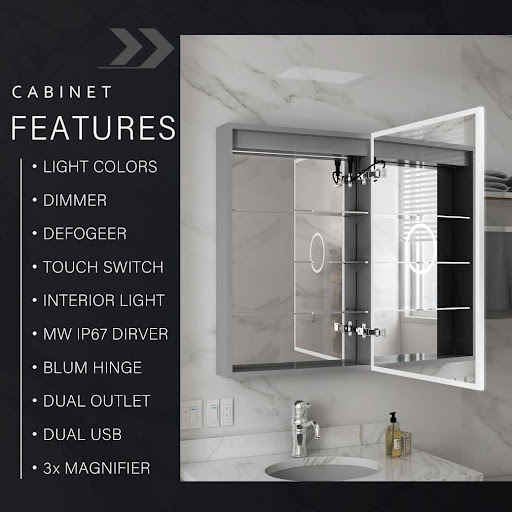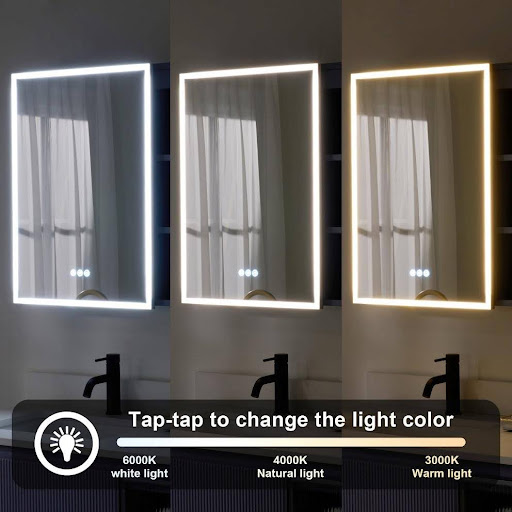Renovating your kitchen can be costly, especially considering the expenses of new appliances, countertops, and medicine cabinets. For homeowners seeking a budget-friendly yet impactful facelift, focusing on the kitchen’s visual linchpin—the cabinets—offers a practical solution.
This guide provides a systematic approach to breathing new life into your wood medicine cabinets. Beyond the simplicity of selecting a paint color, our step-by-step instructions ensure that each brushstroke contributes to a refined transformation, elevating the aesthetic appeal of your kitchen.
Join us as we take you through everything you need about painting wood medicine cabinets.
Table of Contents
Why Should you Paint Wooden Cabinets?
Painting wooden cabinets is a practical and cost-effective strategy for kitchen remodels, ensuring you adhere to a timeless style. Whether your medicine cabinets boast oak, maple, cherry, or walnut finishes, opting to paint allows you to maintain the beautiful wood grain while injecting life into your dated space.
This approach revitalizes your kitchen aesthetically and presents an ideal option for those seeking an economical and stylish transformation.
7-Step Comprehensive Guide to Painting Wooden Medicine Cabinets
Refresh the look of your wooden medicine cabinet with a straightforward painting endeavor, requiring only a few tools and materials. What’s even better? You can tackle this project independently and wrap it up on a weekend. The key is having the right supplies and following the steps to ensure efficient painting process. Let’s take a look at these steps below in detail.
Step 1: Thoroughly Clean Cabinet Doors
Initiate the process by ensuring your wood medicine cabinet doors are impeccably clean. For that, you need to wipe down surfaces with a damp cloth or sponge, paying meticulous attention to hard-to-reach areas, especially on the tops of doors and drawers. Before proceeding, ensure all surfaces are devoid of grease, grime, and dirt.
Step 2: Carefully Detach Cabinet Doors
Precautions must be taken precisely before removing cabinet doors for ease of painting. Safeguard handles by removing screws, secure lock knobs on doors to prevent scratches during detachment, and carefully move them to a designated safe area. Once detached, set aside all accessories in a scratch-resistant location. Ensure doors maintain their original orientation for accurate reattachment.
Step 3: Prime Cabinet Door Fronts and Edges
Prioritize your painted wooden cabinets’ longevity and aesthetic appeal by applying primer in your chosen color. Utilize an electric paint roller and tray combo for a smooth and even application. This protective primer not only guards against staining and scratching but also leaves a pleasing shine to the cabinet doors. Give time for each coat of the primer to dry completely before progressing to the next step.
Step 4: Paint Cabinet Door Fronts with Precision
Select your desired color for the cabinet door fronts, ensuring they complement the existing kitchen aesthetics. Employ one of three painting techniques—rolling, brushing, or spraying—for optimal results. Apply one or two coats of your chosen color, allowing sufficient drying time between each coat. This meticulous approach guarantees vibrancy and a flawless finish.
Step 5: Detail-Oriented Care for Frames
Extend the same meticulous care to the frames as applied to the doors. Ensure cleanliness, dryness, and the absence of any dust or debris on the frames. Apply a coat of primer, meticulously covering all surfaces. Allow each coat of primer to dry completely before advancing to the painting stage. This detailed approach contributes to achieving flawlessly painted wood medicine cabinets.
Step 6: Artful Painting of Edges
Add a refined finishing touch by painting the edges of the medicine cabinet doors. Use painter’s tape to meticulously remove surrounding areas, preventing unintentional color mixing. Apply a fairly thick paint line at the edges, ensuring an even smooth finish. Allow the paint to dry overnight before cautiously removing the tape. Consider an additional coat if necessary for a perfect result.
Step 7: Reattach Doors with Precision
Once your medicine cabinet with lights or simple medicine cabinet is entirely painted in your chosen color, the final step involves reattaching the doors. Clean the edges thoroughly and take precautionary measures to protect them from scratches using painter’s tape. If specific reattachment order matters, refer to your list to avoid oversights. When removing the tape, exercise caution to prevent any accidental smudging. Your rejuvenated wood cabinets are ready to grace your space with a refreshed and polished allure.

Conclusion
Ultimately, this article is a practical guide to transforming your kitchen by painting wood medicine cabinets. Each step has been meticulously outlined, from cleaning and detaching cabinet doors to priming, painting, and reattaching. When you follow the right steps, you can explore a cost-effective and accessible solution to rejuvenate your kitchen’s aesthetic without needing a full-scale renovation.
FAQs
Is Painting or Replacing Kitchen Cabinets More Cost-Effective in a Renovation?
Painting wooden medicine cabinets with lights presents a cost-effective alternative to the substantial expenses associated with replacing them during a kitchen renovation. Renovating a kitchen, known for its hefty costs, often allocates nearly 40 percent of the budget to cabinet replacement alone.
For a 10-by-12-foot kitchen, new cabinets can range around $3,300 – $12,500, potentially offering lower quality than the existing ones. In contrast, the transformative impact of a few fresh coats of paint on your current cabinets comes at a fraction of the cost—typically around $200, accompanied by just a weekend or two of your time. This cost-efficient approach allows you to revitalize your kitchen aesthetic without compromising quality or breaking the bank.
Which Paint is Recommended for Painting Wooden Medicine Cabinets?
Selecting the best paint for wooden medicine cabinets involves aligning it with your home’s colors and décor. Opt for a lighter shade for a light color scheme, while bold colors may benefit from a choice in the middle of the color spectrum. This personalized approach ensures a harmonious blend that complements your cabinet’s aesthetics and seamlessly integrates with your home’s overall design.





